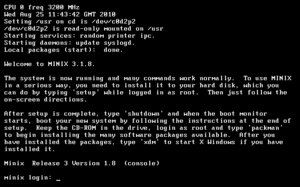MINIX 2.0

The MINIX 3.1.8 boot screen
|
|
| Developer | Andrew S. Tanenbaum |
|---|---|
| Written in | C |
| OS family | Unix-like |
| Working state | Current |
| Source model | Open source |
| Initial release | 1987 |
| Latest release | 3.4.0 / January 2016 |
| Marketing target |
Teaching (v1, v2) Embedded systems (v3) |
| Available in | English |
| Platforms | PC compatibles, PC, PC/AT, PS/2, Motorola 68000, SPARC, Atari ST, Commodore Amiga, Macintosh, SPARCstation, Intel 386, NS32532, ARM, INMOS transputer |
| Kernel type | Microkernel |
| License | Originally proprietary, BSD license since 2000 |
| Official website | minix3 |
MINIX (from "mini-Unix") is a POSIX-compliant (since version 2.0),Unix-like computer operating system based on a microkernel architecture.
Early versions of MINIX were created by Andrew S. Tanenbaum for educational purposes. Starting with MINIX 3, the primary aim of development shifted from education to the creation of a highly reliable and self-healing microkernel OS. MINIX is now developed as open-source software.
MINIX was first released in 1987, with its complete source code made available to universities for study in courses and research. It has been free and open-source software since it was re-licensed under the BSD license in April 2000.
Andrew S. Tanenbaum created MINIX at Vrije Universiteit in Amsterdam to exemplify the principles conveyed in his textbook, Operating Systems: Design and Implementation (1987).
An abridged 12,000 lines of the C source code of the kernel, memory manager, and file system of MINIX 1.0 are printed in the book. Prentice-Hall also released MINIX source code and binaries on floppy disk with a reference manual. MINIX 1 was system-call compatible with Seventh Edition Unix.
...
Wikipedia
